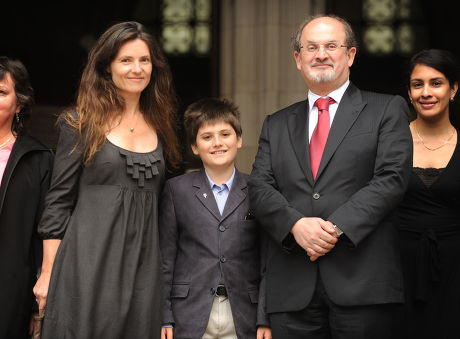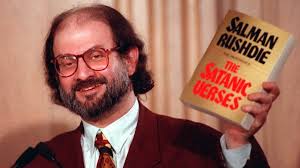Who is Salman Rushdie?
Salman Rushdie is a renowned British-Indian author, best known for his controversial and acclaimed work The Satanic Verses. Born on June 19, 1947, in Mumbai, India, Rushdie gained fame for blending magical realism with historical fiction, addressing themes of identity, cultural conflict, and religious tension. His work has sparked debates on freedom of expression, particularly after the publication of The Satanic Verses, which led to a fatwa calling for his death. Despite facing threats to his life, Rushdie has continued to write and be a strong voice in global literary and political discussions.
Early Life and Education
Salman Rushdie was born on June 19, 1947, in Mumbai, India, to a Muslim family with a long-standing history in the subcontinent. His father, Anis Rushdie, was a successful businessman, while his mother, Negin Bhatt, hailed from a well-educated and intellectual background. The Rushdie family belonged to the growing urban elite in India, and Salman spent much of his early years in the city. Mumbai’s rich cultural and intellectual atmosphere had a profound influence on Rushdie’s development as a writer.
Rushdie’s education began at the prestigious Cathedral and John Connon School in Mumbai, where he excelled in his studies. At the age of 14, he moved to England to continue his education. He attended Rugby School, an esteemed boarding school, where he became familiar with Western literary traditions, which played a key role in shaping his future as an author. During his time in England, Rushdie developed a keen interest in writing, literature, and philosophy, and he was especially drawn to the works of Western and Eastern authors.
Following his time at Rugby School, Salman Rushdie pursued higher education at King’s College, Cambridge. There, he studied History and graduated with a degree in Arts in 1968. His time at Cambridge further refined his literary tastes and opened his mind to the complexities of history, politics, and the cultural conflicts that would later feature heavily in his writing. It was also here that he began to understand the nuances of identity, especially the blending of Eastern and Western cultures—an experience he would revisit in his works.
Personal Life
Salman Rushdie’s personal life has been marked by both notable relationships and controversy. His romantic relationships, often entwined with his public life, have attracted significant attention over the years. Rushdie has been married four times: to Clarissa Luard, Marianne Wiggins, Elizabeth West, and Padma Lakshmi. His marriage to Padma Lakshmi, the famous Indian-American model and television personality, in 2004 attracted widespread media coverage. However, their relationship ended in divorce in 2007.
Despite these high-profile relationships, Rushdie has been very private about his personal life. Much of his focus has remained on his work, his activism for free speech, and his support for literary endeavors. Rushdie has also been a strong advocate for multiculturalism and the celebration of cultural diversity in society, both through his personal views and the themes embedded in his books.
Rushdie’s personal life took a dark turn in the 1980s, following the publication of The Satanic Verses. The book, which addressed themes of religion, identity, and cultural assimilation, sparked protests across the Muslim world. In 1989, following the issuing of a fatwa by the Iranian government calling for his death, Rushdie was forced into hiding. For several years, he lived under police protection, unable to live a normal life. His life during this period was marked by fear and isolation, but he also became a symbol of the fight for freedom of expression.
Family
Salman Rushdie’s family has been an influential part of his personal and professional life. His father, Anis Rushdie, was a successful businessman, while his mother, Negin Bhatt, was an educated and independent woman. His family’s background gave him a unique perspective on the tensions between East and West, and this theme would be explored in depth in his writing.

Rushdie’s parents were initially supportive of his academic ambitions, even though their own backgrounds were more rooted in business and family. His father’s background as an entrepreneur and his mother’s focus on education gave Salman the freedom to pursue his interests in literature, which ultimately led to his success as a writer.
Salman Rushdie has one son, Zafar, from his first marriage to Clarissa Luard. He has also had significant relationships with other children, including from his marriage to Padma Lakshmi. Despite the attention his marriages and divorces have attracted, Rushdie’s relationship with his family has remained an important aspect of his life, providing him with both support and inspiration throughout his career.
Detailed Bio Table
| Attribute | Details |
|---|---|
| Full Name | Salman Rushdie |
| Date of Birth | June 19, 1947 |
| Place of Birth | Mumbai, India |
| Nationality | British-Indian |
| Height | 6 feet (183 cm) |
| Parents | Anis Rushdie (Father), Negin Bhatt (Mother) |
| Net Worth (2025) | $20 million |
Career
Salman Rushdie’s literary career spans more than four decades and has been both celebrated and controversial. His career began in the 1970s when he wrote his first novel, Grimus (1975), which, although not commercially successful, introduced Rushdie’s unique style of writing and themes. His next work, Midnight’s Children (1981), brought him widespread recognition. The novel, which blends history, magic, and reality, won the Booker Prize and was hailed as one of the greatest works of contemporary literature. Midnight’s Children also explores themes of post-colonialism and the complex nature of identity in modern India.
Rushdie’s success continued with the publication of Shame (1983), a political satire that addresses the internal conflicts of Pakistan. The novel, like Midnight’s Children, uses a mixture of fantasy and reality to explore real-world issues, a technique that would become characteristic of Rushdie’s writing style. However, it was The Satanic Verses (1988) that cemented his place in the literary world and made him an international figure.
The Satanic Verses stirred controversy due to its portrayal of Islamic history and its criticism of certain religious doctrines. The novel was banned in several countries, and Rushdie was subject to a fatwa issued by Iran’s Ayatollah Khomeini, which called for his death. This fatwa led to years of living under police protection, during which time Rushdie continued to write. He published several books during this period, including Haroun and the Sea of Stories (1990), a children’s novel, and The Moor’s Last Sigh (1995), a multi-generational saga set in India.

Rushdie’s career continued to flourish in the 21st century with the publication of books such as The Ground Beneath Her Feet (1999) and Shalimar the Clown (2005). These works, though not as universally acclaimed as Midnight’s Children, continued to explore themes of migration, displacement, and cultural hybridity. Rushdie’s literary contributions have made him one of the most important voices in contemporary literature.
In addition to his novels, Salman Rushdie has also written essays, short stories, and articles on topics ranging from literature to politics and free speech. He has served as a voice for artistic freedom, often participating in public debates on censorship, freedom of expression, and the role of the writer in society. His work has earned him numerous accolades, including honorary degrees and prestigious awards, and his influence on global literature remains undeniable.
Throughout his career, Salman Rushdie has navigated the complex intersections of identity, culture, and politics, creating works that challenge readers to think critically about the world around them. His life and career remain a testament to the power of words, the importance of free expression, and the ability of literature to transcend borders.
| Year | Work | Description |
|---|
| 1975 | Grimus | Rushdie’s first novel, a blend of science fiction and fantasy, which received mixed reviews. |
| 1981 | Midnight’s Children | Won the Booker Prize; a magical realist work exploring post-colonial India and the lives of its children. |
| 1983 | Shame | A political satire about Pakistan’s turbulent history and its complex social structures. |
| 1988 | The Satanic Verses | Controversial novel leading to widespread protests and a fatwa calling for his death by Iran’s Ayatollah. |
| 1990 | Haroun and the Sea of Stories | A children’s novel inspired by Rushdie’s own struggles with censorship, blending fantasy and reality. |
| 1995 | The Moor’s Last Sigh | A family saga set in India, exploring themes of history, politics, and personal identity. |
| 1999 | The Ground Beneath Her Feet | A novel combining rock and roll culture with myth, telling the story of a pop singer’s rise and fall. |
| 2005 | Shalimar the Clown | Explores Kashmir’s history and the complex relationships between India, Pakistan, and the West. |
| 2008 | The Enchantress of Florence | A historical novel set in the Mughal Empire, focusing on the clash of cultures and political intrigue. |
| 2012 | Joseph Anton | A memoir detailing his life under the fatwa and his experiences with exile, fear, and survival. |
| 2017 | The Golden House | A political thriller set in contemporary America, exploring themes of identity, power, and corruption. |
| 2019 | Quichotte | A modern retelling of Don Quixote, addressing contemporary issues such as immigration and media influence. |
Latest News on Salman Rushdie
As of February 10, 2025, Salman Rushdie is confronting his alleged assailant, Hadi Matar, in a trial concerning the attempted murder that occurred in August 2022. Matar, a 27-year-old from New Jersey, is accused of stabbing Rushdie during a lecture at the Chautauqua Institution in New York. The attack resulted in Rushdie losing sight in one eye and sustaining severe nerve and liver damage. Matar has pleaded not guilty to charges of attempted murder and assault. The trial, which commenced with opening statements from attorneys, is expected to last between one week and ten days. Prosecutors plan to present videos and photographs from the day of the attack. The case has drawn significant attention, reflecting the ongoing concerns about freedom of expression and the safety of authors worldwide.
Social Media Accounts Table with Official Links
| Platform | Username | Official Link |
|---|---|---|
| @SalmanRushdie | Twitter Profile | |
| @salmanrushdie | Instagram Profile |
Height and Physical Appearance
Salman Rushdie stands at a height of 6 feet (183 cm), with a distinguished and intellectual presence. He has dark, graying hair, often neatly trimmed, and expressive facial features that reflect his deep thoughts and literary prowess. His appearance exudes confidence, with a calm yet determined demeanor.
Net Worth as of 2025
As of 2025, Salman Rushdie’s estimated net worth is around $20 million. This wealth is primarily derived from his extensive career as a writer, his books’ sales, and his involvement in public speaking engagements. Despite controversies surrounding his work, his literary achievements have made him a successful and well-compensated author, with ongoing recognition for his contributions to literature and freedom of speech.
FAQs
Why is Salman Rushdie so famous?
Salman Rushdie is famous for his groundbreaking novels, especially Midnight’s Children and The Satanic Verses. His works blend history, culture, and magic, tackling themes of identity and post-colonialism. The Satanic Verses sparked global controversy, making him a symbol of the fight for freedom of expression.
Is Salman Rushdie a Pakistani?
No, Salman Rushdie is not Pakistani. He was born in Mumbai, India, to a Muslim family. Though his work has explored South Asian themes, his nationality is Indian-British.
Why did Salman Rushdie leave India?
Salman Rushdie moved to the UK in his teens for education and eventually settled there. He left India for better academic and professional opportunities, which led to his successful literary career.






